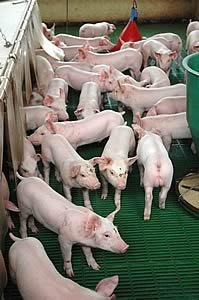 |
|||||||||
|
|||||||||||||||||||
|
|
NADIS Health Report for July 2008 19/08/08 The National Animal Disease Information Service (NADIS) is a veterinary based clinical reporting and surveillance system based upon veterinary surgeons’ on farm visits. As well as recording anecdotal remarks on health issues (summarised in the monthly NADIS report), production and health data is also collected.
This report covers surveillance on farm from mid June to mid July during which time the mild rather than expected hot weather was deemed by some reporters to be favourable to pigs. Some problems were however still attributed to the weather. Sows
Fertility problems were highlighted in some farms, with irregular returns commonly identified. These suggest post service failure and whilst disease (e.g. PRRS) was suspected in some cases, management fault and unidentified causes were reported. Separate cases of outbreaks of premature farrowing (occurring simultaneously with increase in return to service within the herd) and stillbirths/very late mummification are strongly suggestive of infectious disease and there has been some speculations over the role of PCV2 here. This virus has the capacity to produce such problems, but its actual role is unclear. Pressure on staff tends to feature frequently in fertility related problems; difficulties with coping with demands of batch serving was blamed for high return rates on two farms whilst staff shortages in one case were blamed for increase in returns using AI where improperly trained staff had been involved. Mange was sporadically reported in sows although this long recognised disease is believed to be absent from a high proportion of commercial farms particularly as most breeding stock nowadays is derived from mange free farms. MMA affecting milk output and subsequent piglet growth caused concerns but with the appropriate veterinary attention and treatment, was rapidly resolved. Piglets Furthermore, in separate situations, navel and joint infection were considered to have arisen:
Injuries to piglets were highlighted:
Weaners Post weaning fading and respiratory disease was reported sporadically, although not necessarily always associated with PCV2 challenge. Feed and water availability and variations in size of pig at weaning were contributory factors. Strep suis infection causing meningitis, acute fatal septicaemia or as part of the post weaning respiratory complex – including the frequently seen “Glässers Disease” type syndrome - was a common feature. However, an unusual syndrome of flaccid paralysis and death in weaners was considered to be due to an encephalomyelitis of unknown origin affecting 1% or more of weaners on one large commercial breeder-weaner farm. Overstocking continues to be frequently noted for a wide range of reasons including excess farrowing, better than target performance and shortage of follow on accommodation delaying moves. The slowing of growth associated with overstocking, creates a vicious circle of problems within the continual production farm. Various skin problems featured in reports with Greasy Pig Disease prominent but problems also with flies and straw mites causing irritation that must be carefully differentiated from mange. Sudden deaths associated with antioxidant deficiency (Vitamin E, Vitamin C and Selenium) were seen in one complex problem herd with investigation ongoing as to why these particular pigs should have a higher than normal requirement. Post mortem examinations revealed both Mulberry Heart Disease and Hepatitis Dietetica (ruptured liver) typical of this syndrome. Scour and looseness were infrequently seen with the general picture suggesting a lower prevalence of this syndrome than previously seen. Whilst maize in diets was implicated in one problem herd, the introduction of PCV2 vaccination is being linked by some reporters with non-specific health improvements. Growers and Finishers Stocking rates continue to be a cause of concern. Overstocking was seen as a result of excess production from the breeding herd as well as in a herd pushing up slaughter weight without the necessary space provision. Whilst PCV2 vaccination is expected to improve growth in finishers, care will be needed not to compromise this by overstocking if mortality rates decline significantly. A reduction of 5% in mortality will leave an extra week’s worth of pigs on farm in a breeder-feeder. Until the long term benefits of PCV2 vaccination are recognised and realised, the balance between numbers on farm increasing due to reduced mortality and reducing due to faster growth, a careful watch must be kept on stocking rates. Injuries and skin lesions featured predominantly in reports. Tail biting was widespread, with overstocking again implicated, as well as particularly aggressive individuals starting a problem. A major outbreak in a straw yard was observed although its cause was not stated. Conversely, flank and ear damage was a serious problem in two sites – where tails are docked very short – and interestingly was not evident in the younger pigs that were the first PCV2 vaccinates to come through. Occasional reports of fly bite lesions were received, although this problem may not be as prevalent this year as in 2006 and 2007. Mange was also reported.
As summer drifts into autumn, producers should consider:
Mark White BVSc DPM MRCVS
|
||||||||||||||||||

|
|
||||||||||||||||||
| home | agri-services | pedigree
pen | news | dairy | beef | machinery property | organisations | site map |
|||||||||||||||||||

